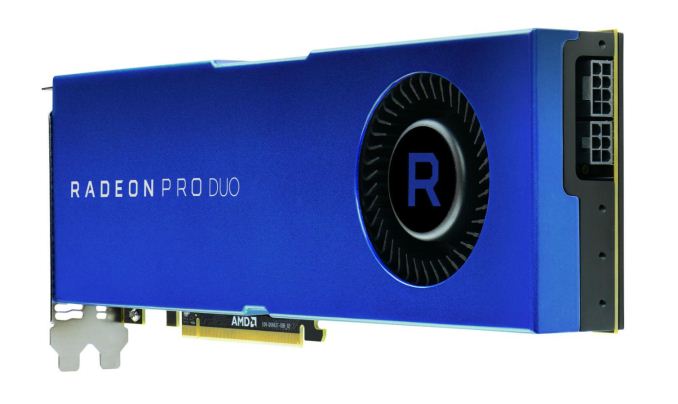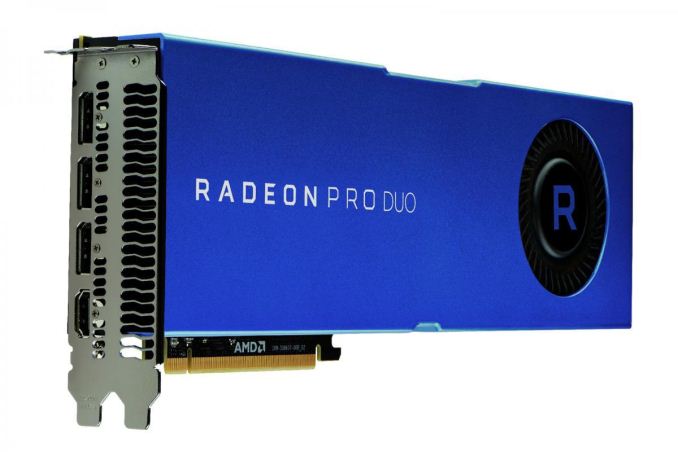AMD Announces Radeon Pro Duo (Polaris) - Double Polaris for Content Creation
by Ryan Smith on April 25, 2017 8:30 AM EST
Back in 2016 AMD launched the Radeon Pro Duo, an interesting take on a semi-pro workstation card. As a dual-GPU Fiji card wasn’t going to be viable for the consumer market, AMD instead focused their attention on developing such a card for the professional content creation market, where the lack of VRAM would be less of an issue and the second GPU more of an asset. The resulting card was best geared for a niche market, but none the less an important one for the company.
Until now, I hadn’t seen any real statistics on how the Radeon Pro Duo was doing in the market or if AMD would follow-up on it with newer products. Now at the 2017 NAB Show we have our answer, as AMD has announced their second Radeon Pro Duo. This time powered by a pair of the company’s Polaris 10 GPUs, the latest Radeon Pro Duo is aimed at roughly the same market as the original, but with all of the improvements that Polaris has brought the consumer market in the past year.
| AMD Workstation Card Specification Comparison | ||||||
| AMD Radeon Pro Duo (Polaris) | Radeon Pro WX 7100 | AMD Radeon Pro Duo (Fiji) | AMD Radeon R9 295X2 | |||
| Stream Processors | 2 x 2304 | 2304 | 2 x 4096 | 2 x 2816 | ||
| Texture Units | 2 x 144 | 144 | 2 x 256 | 2 x 176 | ||
| ROPs | 2 x 32 | 32 | 2 x 64 | 2 x 64 | ||
| Boost Clock | 1243MHz | 1243MHz | 1000MHz | 1018MHz | ||
| Memory Clock | 7Gbps GDDR5? | 7Gbps GDDR5 | 1Gbps HBM | 5Gbps GDDR5 | ||
| Memory Bus Width | 2 x 256-bit | 256-bit | 2 x 4096-bit | 2 x 512-bit | ||
| VRAM | 2 x 16GB | 8GB | 2 x 4GB | 2 x 4GB | ||
| Typical Board Power | 250W | 130W | 350W | 500W | ||
| GPU | Polaris 10 | Polaris 10 | Fiji | Hawaii | ||
| Architecture | Polaris | Polaris | GCN 1.2 | GCN 1.1 | ||
| Manufacturing Process | GloFo 14nm | GloFo 14nm | TSMC 28nm | TSMC 28nm | ||
| Launch Date | 05/2017 | 10/2016 | 04/2016 | 04/21/2014 | ||
| Launch Price | $999 | $649 | $1499 | $1499 | ||
Even though it goes after the same market as the last Pro Duo, the new Polaris-based Pro Duo is a much different card in a number of important ways, virtually all of which have to do with the differences in features and design between the previous Fiji GPU and the newer Polaris 10 GPU. Fiji was a high-end GPU that had to be reined in a bit to fit on a dual GPU card – and even then AMD needed a closed loop liquid cooler – whereas the Polaris 10 GPUs that go into the modern incarnation have a much more workable TDP from the start. Coupled with that, Polaris 10 doesn’t have the fixed VRAM capacity of Fiji, which means AMD can significantly increase the total VRAM. As a result, the new Pro Duo strikes a very different balance than the old card.
By the numbers then, the Polaris-based Radeon Pro Duo is actually slower than the older Fiji version. It has a clockspeed advantage, but this isn’t enough to overcome Fiji’s total stream processor advantage. All told, at peak rates the new Pro duo is rated for 11.45 TFLOPs of FP32, while the Fiji version was rated for 16.38 TFLOPs. In practice however I don’t expect that the gap is quite so large, as Fiji would need to throttle more often, and Polaris enjoys at least a small architectural advantage.
What the new Pro Duo loses in throughput it more than picks up in VRAM. With each Polaris 10 GPU sporting a 256-bit GDDR5 memory bus, AMD has outfit each GPU with 16GB of VRAM, quadrupling their VRAM capacity. AMD’s photos don’t show the bare PCB, but I believe it to be a safe bet that AMD is running 8Gb modules in clamshell mode, meaning the board is truly maxed out. AMD argued that the smaller VRAM capacity of the Fiji based card was not a major liability last year, and while there’s admittedly no reason not to fully equip a Polaris 10 card since the company is back to GDDR5, I do think it’s an important step in making the new card more flexible.
The other big change here is that the TBP has come down significantly, from 350W to 250W. Fiji was powerful, but it was also power-hungry, necessitating the original card’s closed loop liquid cooler. The Polaris Pro Duo, on the other hand, can get away with a simple blower. In fact this is the first time we’ve seen a blower-type dual GPU card from AMD in many years. And though an uncommon choice for a dual GPU card, it makes a great deal of sense given the card’s professional workstation market, as blowers are expected there, and the Radeon WX cards are already similarly equipped.
Under the hood – and particularly catering to the NAB crowd – the move to Polaris means that AMD can now support DisplayPort 1.4 and HDMI 2.0b a significant step up from DP 1.2 and HDMI 1.4b on the previous card. Besides natively supporting contemporary HDMI and HDR displays, this means that AMD can now also drive 8K monitors using a dual-cable setup. All told, the new card comes with 3x DP 1.4 ports and a single HDMI 2.0b port, and can drive all 4 ports at once.
With their new card AMD will be going after the same content creation niche as the old card, which means a mix of video production and VR. The latter in particular is still a growth market for AMD, and the card’s two GPUs means that developers can take advantage of AMD’s Affinity Multi-GPU technology with only a single card. Though to be sure, AMD is positioning and promoting this more like their Radeon WX professional cards, so like its predecessor, the new card will get AMD’s pro drivers and limited official support for the major CAD, CAM, and other engineering software packages.
Wrapping things up, the Polaris-based Radeon Pro Duo will be launching next month at $999. For the moment at least, this puts it at the head of AMD’s professional cards, at least until a WX Vega card finally shows up.
Source: AMD











36 Comments
View All Comments
extide - Wednesday, April 26, 2017 - link
They are trying to massively undercut nVidia to get their foot into this market a bit more heavily. They have put a lot of effort into software for this market lately and it is all open source. HIP is a good example as it allows you to automatically convert CUDA code into native code that can run on AMD GPU's with only a little bit of manual massaging work required afterwards. They have several other frameworks out there as well, so it's a bit naive saying their software sucks without doing at least a little bit of research to know what you are talking about. Check this out: http://gpuopen.com/professional-compute/Yojimbo - Wednesday, April 26, 2017 - link
"They are trying to massively undercut nVidia to get their foot into this market a bit more heavily."I don't think so. If so then we should see AMD's market share soar unbelievably in the next 6 months, or we should see the prices for NVIDIA's Quadro products crash. I wouldn't hold my breath if I were you.
As far as GPUOpen, there's a reason it's Open, and that's because AMD is not sufficiently supporting it themselves. But, without looking, from what I remember their professional visualization software isn't included in GPUOpen, anyway. GPUOpen consists of gaming and compute libraries. As far as HIP, dream on, it doesn't work that way. Even Otoy, which has been trying to get their CUDA code to run on AMD and I presume PowerVR GPUs, said that AMD's Boltzmann Initiative wasn't useful for them. (https://render.otoy.com/forum/viewtopic.php?f=9&am...
I have done research about what I am talking about. Besides, common sense says that if any of those frameworks worked then AMD would be selling GPUs like hotcakes for machine learning and other acceleration tasks that NVIDIA GPUs sell for. Unless NVIDIA's hardware is superior. If it's not the software, it must be the hardware. You must pick one or the other. Instead, you buy the swill PR that AMD keeps feeding to you about how their next product is going to be so successful.
xype - Wednesday, April 26, 2017 - link
Nvidia has had better cards for quite a while and Apple has stuck to AMD. Why do you think that would change?I’ve read somewhere that Nvidia has sued Apple a while back, and shortly after that point Apple went all-AMD. If that article was true (I can’t for the life of me find it anymore), I don’t think Apple will go Nvidia anytime soon.
Yojimbo - Wednesday, April 26, 2017 - link
"Nvidia has had better cards for quite a while and Apple has stuck to AMD. Why do you think that would change?"The reason I think it will change is because I read that NVIDIA has been posting job ads looking for Metal programmers to work with "the next generation of exciting Apple products" or something along those lines. As for why Apple has gone with AMD recently, I don't know. One thing I do know is that Apple likes to tightly control the costs from their suppliers and NVIDIA demands fat profit margins for themselves. AMD probably has offered Apple much better deals. As for why Apple might now switch to NVIDIA, again, I don't know. If I had to guess it's because their customers are clamoring for them. Performance graphics chipsets are not in the commodity category of component supply. They probably can't afford to play the same strong-arm games with graphics chips as they can with other components. In other words, Apple might need NVIDIA more than NVIDIA needs Apple, and that's probably something that has been hard for Apple to swallow. That's just purely my speculation, of course.
"I’ve read somewhere that Nvidia has sued Apple a while back, and shortly after that point Apple went all-AMD."
I don't remember, nor can I find after a quick Google search, NVIDIA ever suing Apple. I found something about NVIDIA and Apple being the target of class action suits related to some of NVIDIA's cards back in 2011.
webdoctors - Tuesday, April 25, 2017 - link
You can thank Nvidia for the huge drop in price. The prior one was $1500, this one had to be less otherwise it wouldn't compete with the Titan series.These aren't the professional cards AMD sells, those are the FirePro cards.
Yojimbo - Tuesday, April 25, 2017 - link
When's the last time AMD came out with a "FirePro" card? I think this "Radeon Pro" branding replaced the "FirePro" when AMD created Radeon Technologies Group.ddriver - Tuesday, April 25, 2017 - link
It's cheap because it is mediocre trash. Bring in Vega already!!!Yojimbo - Tuesday, April 25, 2017 - link
But the hardware doesn't seem that bad. It certainly seems a lot stronger than the price indicates, for a professional card.andychow - Friday, April 28, 2017 - link
The answer is simple. Manager asks "does this support CUDA", engineer says "we actually don't use CUDA", manager buys nVidia because CUDA.hahmed330 - Tuesday, April 25, 2017 - link
I am still in awe of the insane yet surprisingly impressive R9 295X2 500W TDP.